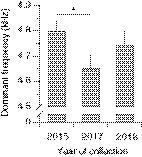Our official English website, www.x-mol.net, welcomes your
feedback! (Note: you will need to create a separate account there.)
Phenotypic plasticity related to temperature induces song variation in the field cricket Gryllus rubens
Ethology ( IF 1.3 ) Pub Date : 2020-05-12 , DOI: 10.1111/eth.13035 Oliver M. Beckers 1
Ethology ( IF 1.3 ) Pub Date : 2020-05-12 , DOI: 10.1111/eth.13035 Oliver M. Beckers 1
Affiliation

|
Mating songs and preferences for these songs have to match for communication to function. Since this match restricts variation, understanding how phenotypic variation is introduced in communication systems is essential for understanding their evolution. The environment, through phenotypic plasticity or parental effects, is an important catalyst for phenotypic variation. In Kentucky, the cricket Gryllus rubens has one reproductive generation in the spring and one in the fall and the mating songs differ substantially between generations. I tested whether these differences in songs are the result of intergenerational (i.e., parental effects) or intragenerational phenotypic plasticity. To test for the role of parental effects on songs, I reared offspring of field‐collected spring and fall females in a common garden environment and recorded their songs. None of the analyzed song characters differed between the sons of fall and spring parents, suggesting that parental effects do not play a role in song development. To test for the effect of phenotypic plasticity on songs, I reared juvenile and adult males in two separate sets of experiments at two different levels of temperature and daylength. Rearing temperature affected every analyzed song character: The higher adult rearing temperature (32°C) induced significantly faster pulse rates, shorter pulse durations, and higher dominant frequency compared with the lower rearing temperature (24°C). The higher juvenile temperature induced significantly shorter pulse durations, longer interval durations, and lower pulse duty cycles than the lower rearing temperature. Rearing photoperiod did not affect male song development. The changes induced by the temperature treatments paralleled those observed in the wild, suggesting that the seasonally different songs in Kentucky are primarily the result of seasonal temperatures. Possible evolutionary consequences of the temperature‐related phenotypic plasticity are discussed.
中文翻译:

与温度有关的表型可塑性引起the在田间的歌唱变化
匹配歌曲和这些歌曲的首选项必须匹配才能正常通信。由于这种匹配限制了变异,因此了解通信系统中如何引入表型变异对于理解其进化至关重要。通过表型可塑性或父母效应,环境是表型变异的重要催化剂。在肯塔基州,板球G在春季有一个生殖世代,在秋季有一个生殖世代,并且不同世代之间的交配歌曲大不相同。我测试了歌曲中的这些差异是代际(即父母效应)还是代内表型可塑性的结果。为了测试父母对歌曲的影响,我在一个普通的花园环境中饲养了田野采集的春秋两季雌性的后代,并录制了他们的歌曲。所分析的歌曲特征在秋季和春季父母的儿子之间均没有差异,这表明父母的影响在歌曲的发展中不起作用。为了测试表型可塑性对歌曲的影响,我在两个不同的温度和白天水平下,分别进行了两组实验,分别饲养了成年和成年男性。饲养温度影响每个分析的歌曲特征:与较低的饲养温度(24°C)相比,较高的成人饲养温度(32°C)显着提高了脉冲频率,缩短了脉冲持续时间并提高了主频率。与较低的饲养温度相比,较高的少年温度引起的脉冲持续时间明显短,间隔持续时间更长,脉冲占空比较低。饲养光周期不影响雄歌的发育。温度处理引起的变化与在野外观察到的变化相似,这表明肯塔基州季节性不同的歌曲主要是季节性温度的结果。讨论了与温度有关的表型可塑性的可能演变结果。与较低的饲养温度(24°C)相比,较高的主频。与较低的饲养温度相比,较高的少年温度引起的脉冲持续时间明显短,间隔持续时间更长,脉冲占空比较低。饲养光周期不影响雄歌的发育。温度处理引起的变化与在野外观察到的变化相似,这表明肯塔基州季节性不同的歌曲主要是季节性温度的结果。讨论了与温度有关的表型可塑性的可能演变结果。与较低的饲养温度(24°C)相比,较高的主频。与较低的饲养温度相比,较高的少年温度引起的脉冲持续时间明显短,间隔持续时间更长,脉冲占空比较低。饲养光周期不影响雄歌的发育。温度处理引起的变化与在野外观察到的变化相似,这表明肯塔基州季节性不同的歌曲主要是季节性温度的结果。讨论了与温度有关的表型可塑性的可能演变结果。饲养光周期不影响雄歌的发育。温度处理引起的变化与在野外观察到的变化相似,这表明肯塔基州季节性不同的歌曲主要是季节性温度的结果。讨论了与温度有关的表型可塑性的可能演变结果。饲养光周期不影响雄歌的发育。温度处理引起的变化与在野外观察到的变化相似,这表明肯塔基州季节性不同的歌曲主要是季节性温度的结果。讨论了与温度有关的表型可塑性的可能演变结果。
更新日期:2020-05-12
中文翻译:

与温度有关的表型可塑性引起the在田间的歌唱变化
匹配歌曲和这些歌曲的首选项必须匹配才能正常通信。由于这种匹配限制了变异,因此了解通信系统中如何引入表型变异对于理解其进化至关重要。通过表型可塑性或父母效应,环境是表型变异的重要催化剂。在肯塔基州,板球G在春季有一个生殖世代,在秋季有一个生殖世代,并且不同世代之间的交配歌曲大不相同。我测试了歌曲中的这些差异是代际(即父母效应)还是代内表型可塑性的结果。为了测试父母对歌曲的影响,我在一个普通的花园环境中饲养了田野采集的春秋两季雌性的后代,并录制了他们的歌曲。所分析的歌曲特征在秋季和春季父母的儿子之间均没有差异,这表明父母的影响在歌曲的发展中不起作用。为了测试表型可塑性对歌曲的影响,我在两个不同的温度和白天水平下,分别进行了两组实验,分别饲养了成年和成年男性。饲养温度影响每个分析的歌曲特征:与较低的饲养温度(24°C)相比,较高的成人饲养温度(32°C)显着提高了脉冲频率,缩短了脉冲持续时间并提高了主频率。与较低的饲养温度相比,较高的少年温度引起的脉冲持续时间明显短,间隔持续时间更长,脉冲占空比较低。饲养光周期不影响雄歌的发育。温度处理引起的变化与在野外观察到的变化相似,这表明肯塔基州季节性不同的歌曲主要是季节性温度的结果。讨论了与温度有关的表型可塑性的可能演变结果。与较低的饲养温度(24°C)相比,较高的主频。与较低的饲养温度相比,较高的少年温度引起的脉冲持续时间明显短,间隔持续时间更长,脉冲占空比较低。饲养光周期不影响雄歌的发育。温度处理引起的变化与在野外观察到的变化相似,这表明肯塔基州季节性不同的歌曲主要是季节性温度的结果。讨论了与温度有关的表型可塑性的可能演变结果。与较低的饲养温度(24°C)相比,较高的主频。与较低的饲养温度相比,较高的少年温度引起的脉冲持续时间明显短,间隔持续时间更长,脉冲占空比较低。饲养光周期不影响雄歌的发育。温度处理引起的变化与在野外观察到的变化相似,这表明肯塔基州季节性不同的歌曲主要是季节性温度的结果。讨论了与温度有关的表型可塑性的可能演变结果。饲养光周期不影响雄歌的发育。温度处理引起的变化与在野外观察到的变化相似,这表明肯塔基州季节性不同的歌曲主要是季节性温度的结果。讨论了与温度有关的表型可塑性的可能演变结果。饲养光周期不影响雄歌的发育。温度处理引起的变化与在野外观察到的变化相似,这表明肯塔基州季节性不同的歌曲主要是季节性温度的结果。讨论了与温度有关的表型可塑性的可能演变结果。











































 京公网安备 11010802027423号
京公网安备 11010802027423号